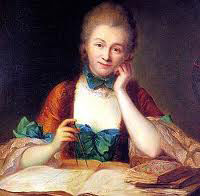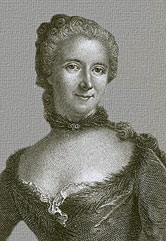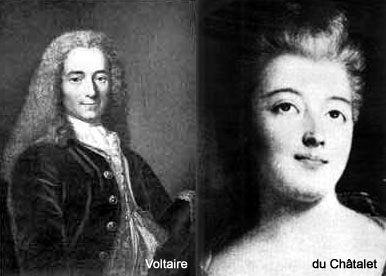Emilie, La Marquise du Ch√Ętalet Defends Her Life Tonight
A play written by Lauren Gunderson, directed by Chloe Bronzan and presented by Symmetry Theatre Company
Daring Genius of the Enlightenment, Emilie du Ch√Ętalet
A biography written by Judith P. Zinsser (Penquin, 2006)
Passionate Minds:Emilie du Ch√Ętalet, Voltaire, and the Great Love Affair of the Enlightenment
A book by David Bodanis (Random House, 2006)
 |
Gabrielle Emilie le Tonnelier de Breteuil, La Marquise du Ch√Ętalet, the 18th century philosopher, physicist, mathematician, author, translator of Newton, mother of four, lover of Voltaire among others and wife of a high-ranking military nobleman, enjoyed some celebrity and controversy during her brief lifetime. Now, more than three hundred years after her birth, she is far better understood and much more respected than at any time during or after her life. Thanks to the persistence, patience and devotion of various scholars and authors in the 20th century, the reputation and contributions of La Marquise were dusted off and reconsidered. Discoveries of letters and other documents led to plays being written and produced in both France and the United States and the publication of two acclaimed and widely read books.
Among her greatest achievements was her translation of Newton's Principia Mathematica from Latin to French. So great was her mastery of mathematics and physics her translation is to this day considered the authoritative version. But she was not a meek linguist locked away with a pile of dictionaries struggling to find the truest and most faithful phrases. Her intellect and curiosity bound her to questioning Newton's assumptions about gravity, mass and momentum so she could illuminate, and in some cases dispute, his hypotheses.
She broke with Newton in a highly controversial, but ultimately universally accepted, reinterpretation and expansion of his definition of force. Newton's explanation was twofold: first, the simple equation force equals mass times velocity (F=mv), which came to be known as momentum, or force morte because the momentum would eventually cease. This, in du Ch√Ętalet's opinion, inadequately explained constant movement such as that which is seen in the movement of planets. Newton dismissed this complication by explaining that, when necessary, God would intervene in these instances and add more force to ensure continuity.
Du Ch√Ętalet found the God theory wanting. She developed the prevailing interpretation of kinetic energy based upon Gottfried Wilhelm von Leibniz's writings: F = mv2. The addition of squaring velocity to Newton's original concept elegantly explained constant motion and came to be known as force vive or living force.
Du Ch√Ętalet worked feverishly until the last moments of her life to ensure her convictions would appear in her translation of Newton's Principia Mathematica and her exhaustive accompanying commentary. It was eventually published but not until ten years after her death in 1749.
In another publication, her Institutions de Physics (Foundations of Physics) she continued and elaborated upon her explorations and belief that mathematics was the true basis of creation and therefore all knowledge. Her mind sought the clarity that mathematics could bring to ideas and concepts that might otherwise be erroneously clouded by emotional interpretations. She mostly provoked notoriety in the form of dim praise, ridicule and, even worse, neglect, by authoring these books and promoting her theories. In 18th century France the fact that a woman dared to be so bold as to enter the realm of ideas ruled by men was considered scandalous.
How interesting then that after three centuries a play has been written and presented in the United States. Symmetry Theater Company, whose mission is to promote gender equity on the stage and tell the untold stories of women, seized the opportunity and produced a thrilling reincarnation of La Marquise.
Playwright Lauren Gunderson chose a metaphysical approach to telling du Ch√Ętalet's story. La Marquise time travels to the theatre (to the beautiful Julia Morgan building, the Berkeley City Club) because she cannot rest peacefully until she has had her say about what really happened in her life. Played with scintillating intelligence and sensuality by Danielle Levin, La Marquise mostly addresses the audience directly while actors play out each of her chosen scenes, with Blythe Foster filling the role of La Marquise in scenes narrated by Levin.
If you think the science is complicated wait until you read about her life.
Born into an aristocratic family she was, as was the custom, married off to a titled suitor, Le Marquis du Ch√Ętalet-Lomont. Her duties as wife included regular attendance at the court of Louis XV and bearing children. "Did I mention I have children?" sums up her feeling about that part of the job.
Bored by the court, except when she was able to use her mathematical superiority to wipe the card tables clean, she sought other interests. As typical as the custom of arranged marriages so was the custom of taking lovers. She was free to take lovers given that her marriage was more a business arrangement than a compact for lifelong companionship. Besides her husband was a leader of the French army and was nearly always required elsewhere.
Director Chloe Bronzan deftly and hilariously handled the entrance of Voltaire, both on center stage and in the center of du Ch√Ętalet's life, by having him grin solicitously at the audience while all of the other actors surrounded and framed him in a tableau of dazzling smiles and shimmering hands. Robert Parsons' Voltaire was a barely tolerable charmer, so egotistical you almost pitied him. Their particular folie √† deux involved a highly dramatic exodus from Paris to du Ch√Ętalet's chateau at Cirey when Voltaire was nearly arrested for his publication of critiques and satires about the French government. Once away from the distractions of home and court, they were free to enslave themselves to their intellectual pursuits. They set up laboratories for their experiments and libraries for their volumes; they read, they wrote, they argued and they made up.
Gunderson's writing and especially Bronzan's direction bring humor and high drama to this solitary life of scholarship and scientific discovery. They write together, they write separately, they share nearly everything and yet they hide elaborate secrets from each other.
Du Ch√Ętalet and Voltaire decide to co-write and submit a paper to a scientific competition on the nature of fire. However, they cannot agree on the findings from their experiments. So, without telling Voltaire, du Ch√Ętalet submits her own paper (Sur la Nature du Feu) and receives honorable mention for her discoveries from L'Academie des Sciences.  Her betrayal is nothing compared to Voltaire's. He wickedly writes criticisms of her theories behind her back and then, after breaking off their sexual relationship, citing "fatigue," he takes up with his young niece. Her betrayal is nothing compared to Voltaire's. He wickedly writes criticisms of her theories behind her back and then, after breaking off their sexual relationship, citing "fatigue," he takes up with his young niece.
Our heroine soon finds a youthful companion of her own, the dashing poet Jean-Fran√ßois Saint-Lambert. The play culminates with du Ch√Ętalet's death, at 43, shortly after giving birth to Saint-Lambert's daughter (though the Marquis claimed paternity). As the phantom du Ch√Ętalet watches the recreation of this birth and death, she delivers a beautiful and highly emotional monologue about the tragedy of dying before being able to complete her work and realize all of her ideas. Danielle Levin's embodiment of these final scenes was agonizingly heartfelt and left the audience mesmerized, if exhausted with sorrow.
Gunderson credits Dr. Judith P. Zinsser, author of Daring Genius of the Enlightenment, Emilie du Ch√Ętalet, as a mentor in helping her create the world of this play. Zinsser is a women's historian and among her goals in this book it is clear that she wanted to decouple du Ch√Ętalet from Voltaire. During and after his lifetime there is vast evidence that he at times degraded du Ch√Ętalet's work but later in life incorporated some of her work into his own oeuvre. It took centuries in some cases for the truth to be known about the actual authorship of some of her publications because they had been credited to Voltaire or fallen into obscurity. Zinsser creates vivid images of 18th century French life by explaining the cultural, intellectual and material world but her sights are on the singular intellect and intellectual achievements of du Ch√Ętalet. In addition to the publications discussed in Gunderson's play, there were numerous others including Examens de la Bible and Discours sur le Bonheur (Examination of the Bible and Discourses on Happiness). Zinsser treats the creation and publication of each as its own distinct story and discusses the intellectual content of the Marquise's oeuvre throughout this lovingly and painstakingly written biography.
David Bondanis' Passionate Minds: Emilie du Ch√Ętalet, Voltaire, and the Great Love Affair of the Enlightenment employs a more novelistic style to carry the reader through from the filthy streets of Paris, through the chateaux and in and around the court, and through the highs and lows of the relationship between the two writers and philosophers. Quoting and lifting from letters and other source materials, he tells La Marquise's story within the context of a country on the verge of revolution during the final decades of the monarchy Voltaire so virulently criticized. Bondanis is a science writer with an eye for the cinematic so he creates lively visuals and compelling scenes for the reader to feel au milieu.
Among the innumerable reasons that du Ch√Ętalet's legacy is so fascinating is the fact that is has been claimed in many ways by others. The reason for the title of Gunderson's play, Emilie, La Marquise du Ch√Ętalet Defends Her Life Tonight, becomes more clear the more one learns about this remarkable woman and how misunderstood she has been until only recently.
 |
Shortly after her untimely death, Voltaire and others began publishing their own versions of the truth about her life and her accomplishments. Others who wrote about her include several people who were in her social milieu and in her employ who did not write particularly flattering accounts of her. The fact that she was a woman working in a field completely dominated by men complicated her reputation further. Her colorful social life and glamorous lifestyle were other contributing factors. But what a welcome discovery to know that accurate information about her contributions to the worlds of science and letters are still being written.
|